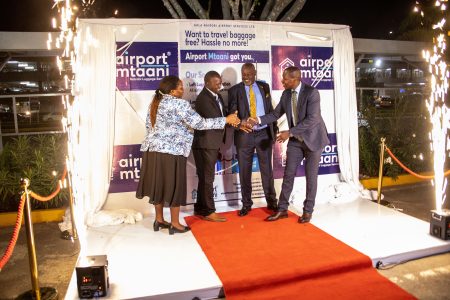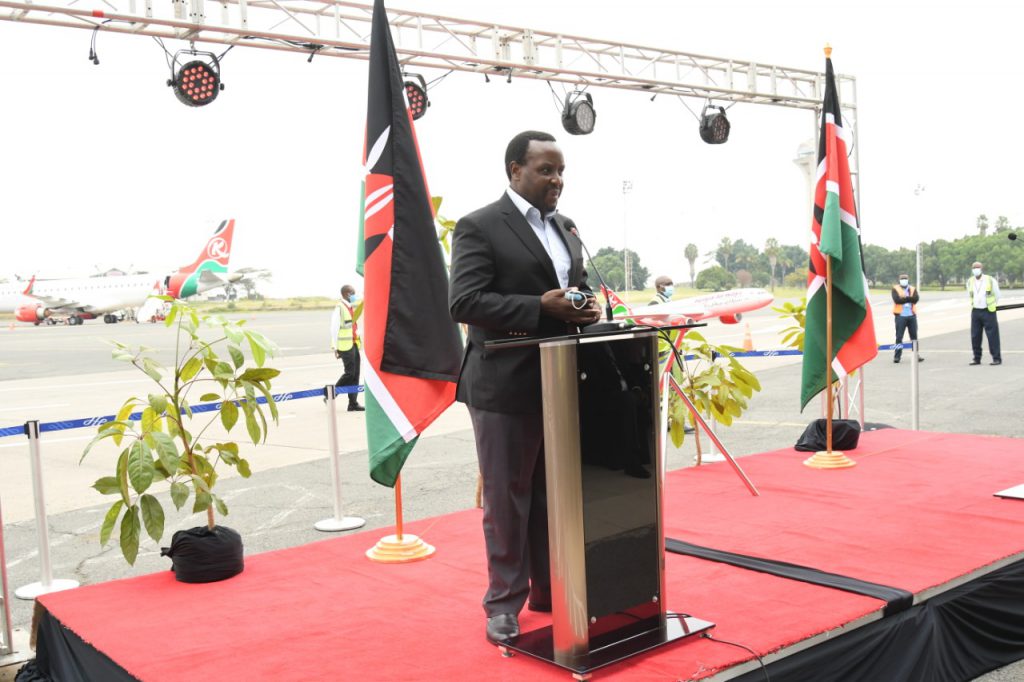Travellers using Jomo Kenyatta International Airport, JKIA, are set to enjoy convenient land-and-leave luggage services following the launch of ‘Airport Mtaani,’ an innovative luggage handling service by Hala Nairobi, a logistics Company based at JKIA. Speaking during the launch at JKIA on Thursday, Airport Mtaani’s Operations Director, Humphrey Mbogo said the service will ease pressure on a busy JKIA as passengers queue to wait for their luggage.
"Our dedicated team will retrieve the baggage at the belt, clear with the customs at KAA and deliver the baggage to your doorstep. Passengers arriving at JKIA domestically with connecting international flights will also have an opportunity to book luggage storage services in our CCTV-controlled storage," he said.
Airport Mtaani will provide a wide range of services including lost luggage inquiries and facilitation, luggage storage for transmitting passengers, and land-and-leave services which will allow passengers to to skip the hustle of luggage claims.
Get in touch with Airport Mtaani
JKIA general manager Selina Gor commended Airport Mtaani terming it a revolutionary idea that will transform the passenger experience at Kenya's largest airport.

JKIA general manager, Selina Gor (Left), Airport Mtaani operations manager Humphrey Mbogo (second from left), KAA Chairman Caleb Kositany (second from right) and Mwingi West MP Charles Nguna (right), shake hands during the official launch of Airport Mtaani. PHOTO| ISAYA BWABI
“The convenience of entrusting your belongings to a reliable luggage delivery business like Airport Mtaani cannot be overstated. Travellers can now bid farewell to the hustle and bustle of dragging heavy luggage when they land at JKIA, they can now enjoy the freedom to effortlessly walk out of the terminal building into their vehicles to their next destination," she said.
On his part, Kenya Airports Authority Chairman Caleb Kositany said plans are underway to expand Jomo Kenyatta International Airport and services like those provided by Airport Mtaani are well in line with the vision of a new JKIA.
“At Kenya Airports Authority we run about 22 airports across the country and we have plans to build a new terminal here [at JKIA] which will be state-of-the-art. This airport is a 1978 architecture that was designed for two million passengers but currently handles about ten million passengers. This [Airport Mtaani] is a Kenyan-driven initiative and we hope that you expand to other East African countries,” Kositany said.
After 99 days of shutdown, the Kenyan air space finally opened Wednesday, July, 15th 2020 for domestic flights which were officially launched at the Jomo Kenyatta International Airport (JKIA), presided over by Cabinet Secretary for Transport, James Macharia.

Transport CS James Macharia flagging off a KQ flight to Mombasa. PHOTO| COLLINS KWALA
President Uhuru Kenyatta had a fortnight ago, ordered that local flights resume in a bid to revive the Kenyan economy which has been hit hard by the Corona Virus pandemic. However, one of the major concerns hovering around the resumption of the flights was the safety of passengers and crew as planes move from one point to another.
The Kenya Airports Authority and other stakeholders in the sector had insisted that as a matter of urgency and for the safety of everyone, all measures had to be put in place before aircraft could be cleared for take-off to any destination across the country. Some of the measures include wearing of facemasks at all times while at airports and airstrips, temperature checks, and social distancing before boarding.

Kenya Airports Authority Acting Director Alex Gitari assured passengers of their safety. PHOTO| COLLINS KWALA| CHAMS MEDIA
And it is the latter that had elicited mixed reactions from Kenyans, with some questioning the rationale behind allowing passengers to sit closely in an aircraft while the same is not allowed in public transport vehicles and even the Standard Gauge Railway (SGR).
According to Kenya Airways Chief Executive Officer Allan Kilavuka, aircrafts are designed in such a way that it is safer to sit closely next to each other than in any other mode of transport, and even in a hospital environment. Kilavuka opines that air circulation in the cabin is near perfect, hence, it is fresh for everyone.
“The way the aircraft is designed in terms of air circulation and filtration system is even better than the hospital environment, and even in terms of design, the way the seating arrangements are, you almost have a shield between you and the person seated in front of you,” said Kilavuka.
He however emphasized the need for strict adherence to other preventive measures such as wearing facemasks at all times while aboard a plane even though he believes that the risks of transmission in the cabin are significantly reduced.

Kenya Airways CEO Allan Kilavuka. PHOTO| COLLINS KWALA | CHAMS MEDIA
The way the manufacturers have designed air circulation is that it moves from up going down and out through filters, so it has reduced the risks. Indeed, there might be some risk between people sitting next to each other but remember we are requiring people to also wear face masks,” Kilavuka added.
Kenya Airways launched its local flights on Wednesday with two flights per day on the Nairobi – Mombasa route while one flight per day set for Kisumu – Nairobi route.
“We came up with a robust protocol that would ensure that as far as possible you do not have a chance of catching the Corona Virus in the airport or aviation ecosystem,” said Gilbert Kibe, Director General of the Kenya Civil Aviation Authority.
In May 2020, the International Air Transport Association (IATA) said in an economics chart that social distancing would cripple most airlines despite the types of aircraft or capacity.
“Depending on the aircraft type and the seat configuration, social distancing could reduce the available seat capacity by 33-50%. And when such policies are pursued, the seat load factor of an aircraft is artificially capped,” read the IATA chart, in part.